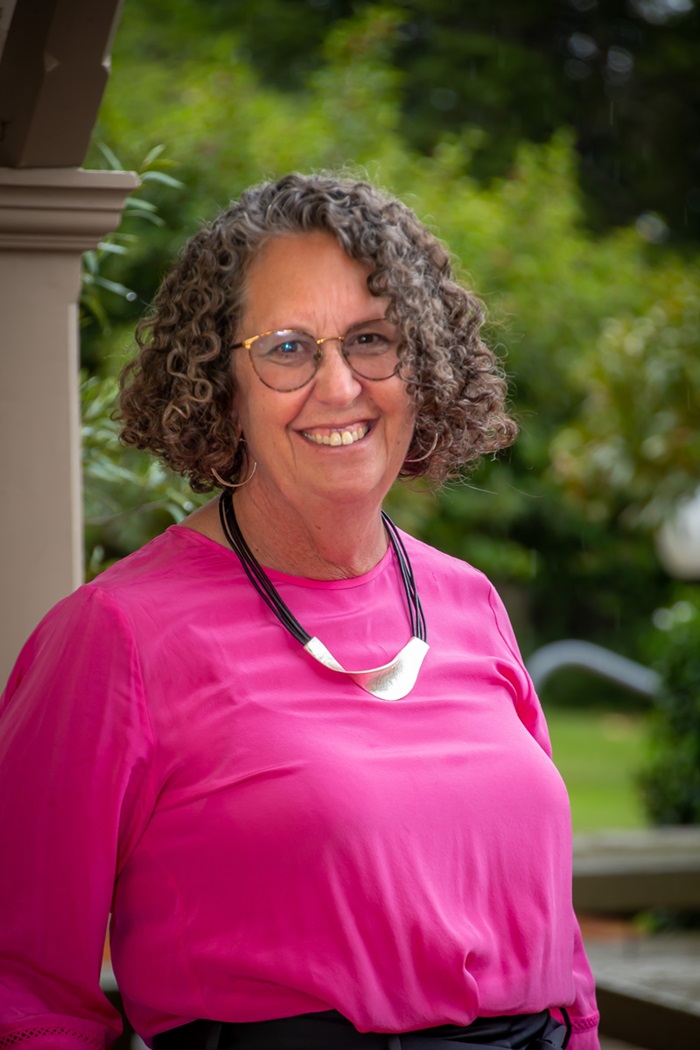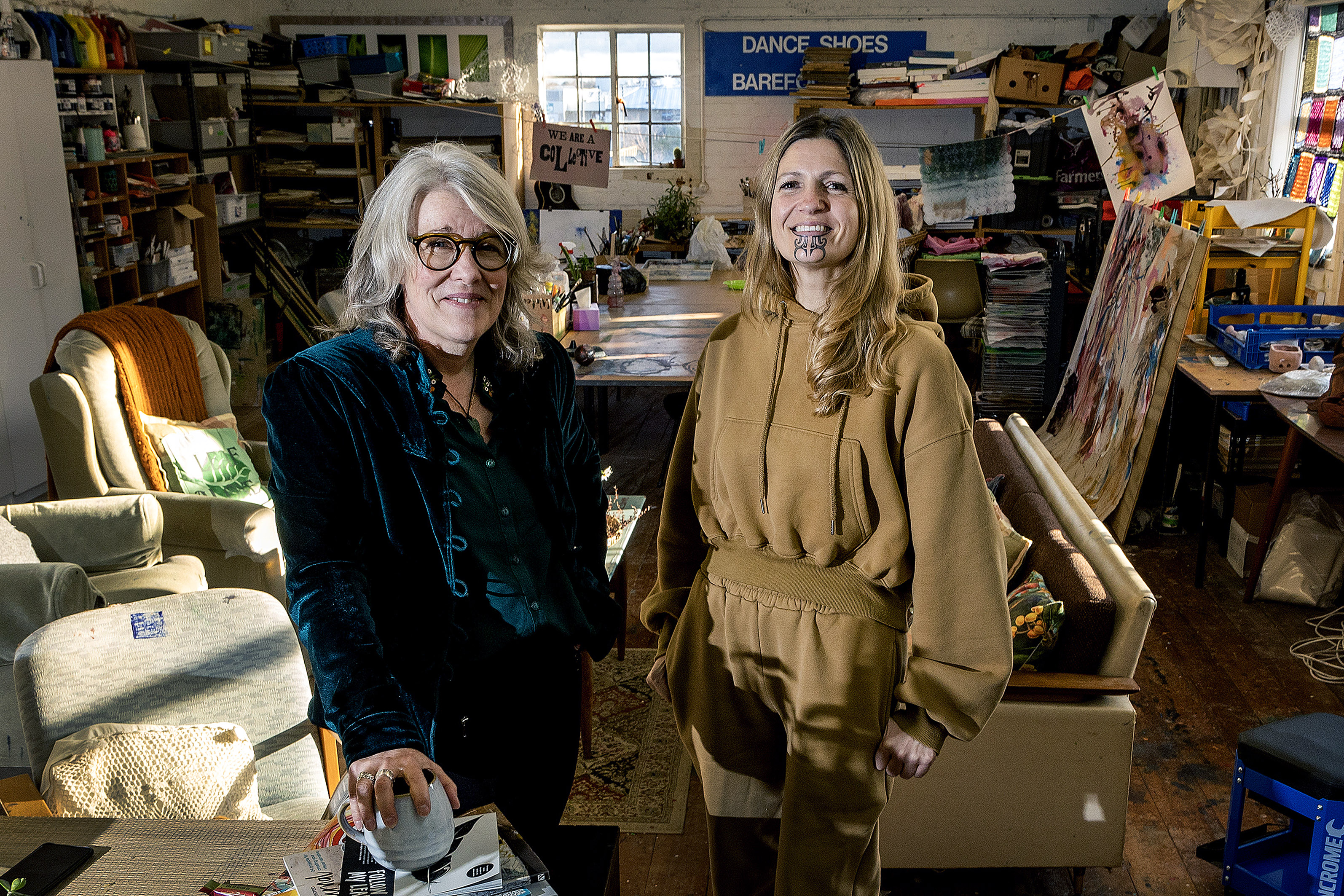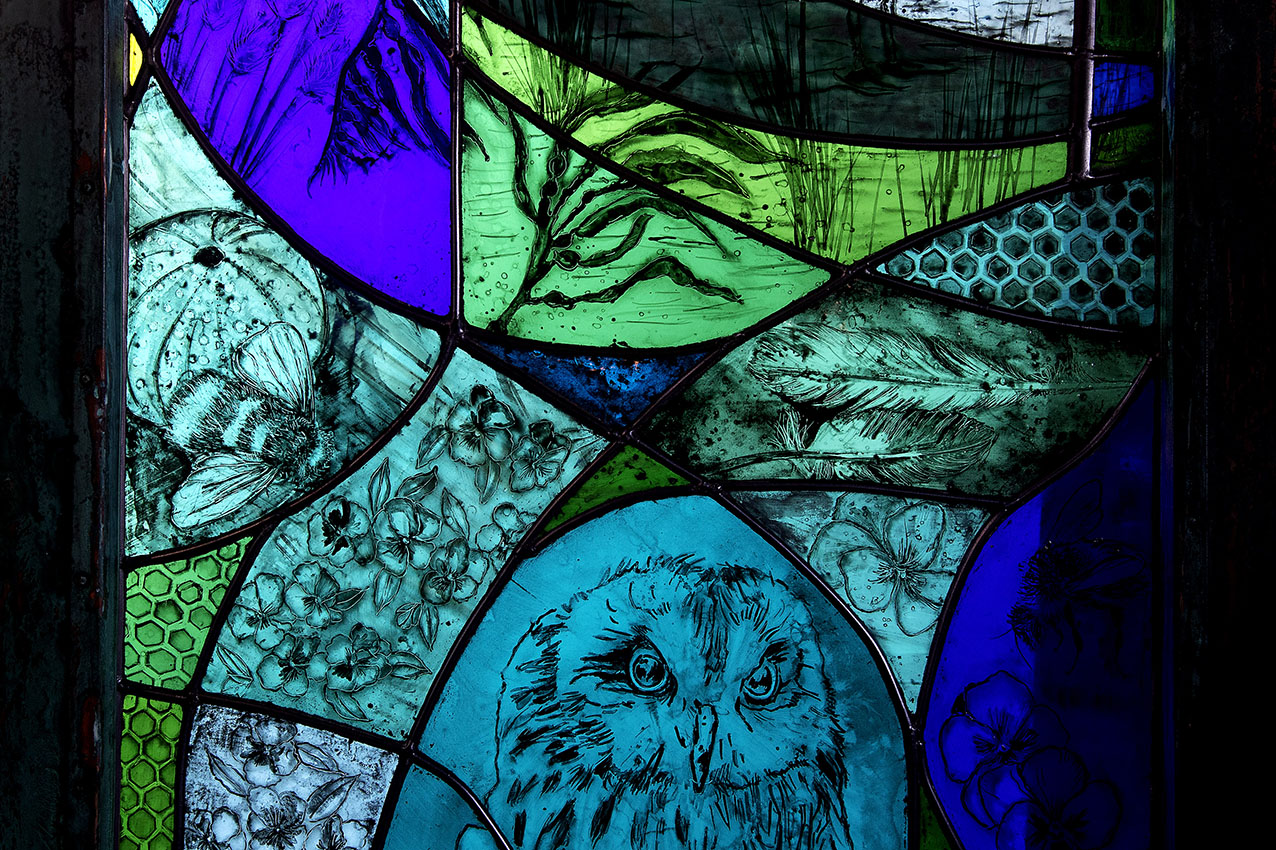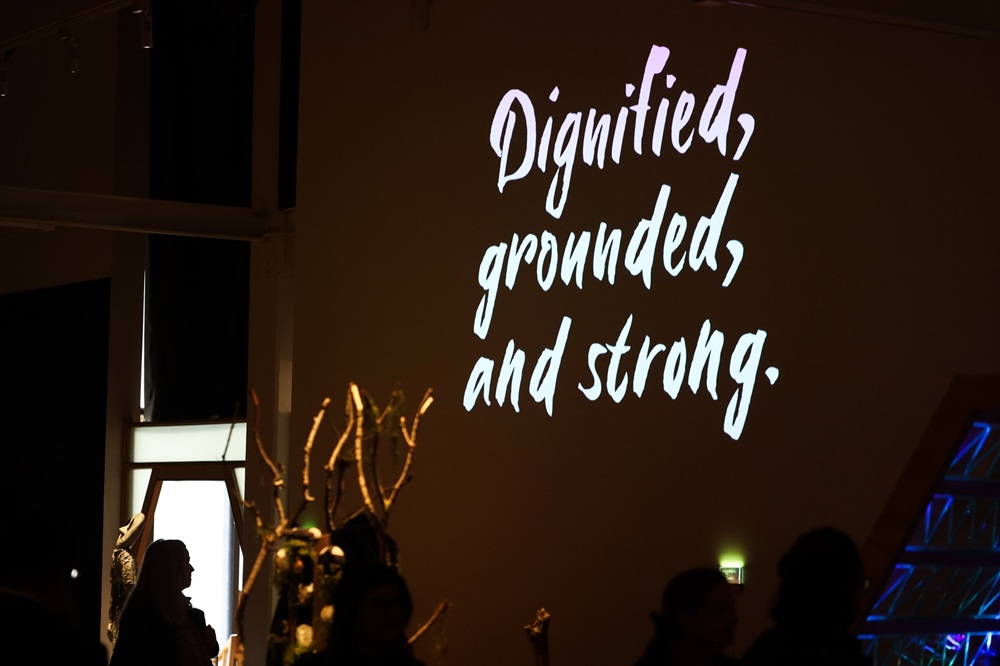Karen Seccombe and WAI – 13 years of collective art making
Founded in 2013 by Te Kunenga ki Pūrehuroa Massey University alumna Dr Karen Seccombe, the Women’s Art Initiative (WAI) began in a tiny local dental clinic with just seven wāhine (women) as a form of resistance and response to violence and abuse they had experienced. Over the past 13 years, WAI has grown from a small art group into a dynamic collective – they shared strong words, challenged negative stereotypes, asked society to take responsibility, and continued to grow.
The beginnings of WAI
The concept of WAI emerged during Karen’s postgraduate studies in Māori Visual Arts in 2012 at Massey. In response to her Master of Māori Visual Arts exhibition – a series of twelve large paintings exploring her experiences of violence – Karen was met with powerful social responses. “I painted because I didn’t want to talk – but I was asked to speak publicly about the works. I sat with them for two weeks and interacted with the public, hearing many disclosures and felt a huge sense of reclamation of power through voicing this narrative.” Karen shares, “If this approach gave me a voice, then I felt it might for other wāhine also.”
She approached Palmerston North Women’s Refuge to see if they were keen to walk alongside an art group for women who had experienced violence. With a great deal of trust, goodwill, tautoko, and aroha, the WAI seed was planted. “At the end of that year, I approached the school I taught at as a primary school teacher, and they allowed us to use the dental clinic. It was a tiny, compressed little space with two tables in it. We cobbled together things, and that’s how we started with seven women and the little dental clinic,” Karen says.

Karen and her artwork - Photo credit - Warwick Smith
A collective approach
The vision was clear: to create a space that was not therapy-based but facilitated autonomy with collective processes around the exhibition. “Our core mission is around creative connection, and it’s enabling voice through art making,” Karen says.
Kelly Jarvis, Te Aitanga a Hauiti, one of the first founding members, shares that “it’s the way we treat each other as a collective that each of our voices is important, no matter in which way we speak them or which words, how we string those words together, all our making is beautiful. There’s no defined way of making art.”
Professor Tracy Riley, Dean of Postgraduate Research at Massey University and WAI Trust board Chair, highlights the collective’s unique dynamics: “It is about bringing people together, bringing their strengths together, and letting them express their experiences, who they are as people, just to be themselves.” She elaborates on the importance of this organic, self-driven growth, explaining that “from the board’s perspective, we want to be able to support the facilitators and the women who are part of this collective to continue with their art practice and with their use of art as a form of resistance to violence. But it can’t be shaped. We can’t shape it as a board. We must let the collective shape what and how they engage with one another.”

Professor Tracy Riley
“Our art work is about us”
WAI’s mission centres on enabling wāhine and rangatahi who have experienced violence to connect through creativity. “Our art work is about us – our experiences, responses to these and other people’s responses to us, identities, relationships, and desire to see social change.”
WAI provides resources, facilitation, and safe spaces for creating and exhibiting art, challenging the stigma and shame that often silences survivors. “Every time we exhibit, we educate by exposing hidden and marginalised narratives,” Karen notes.
“Our history of exhibiting here in the Manawatū community has built awareness and shared robust, critical, authentic information,” Karen shares, “I think we are educating the public. We know who we are – it is a space for reclaiming and recognising our identities. That light that we’ve always carried within us has stayed with us throughout the dark times, and that is the spark that we’re bringing to many of the artworks, impact-wise, on the local community. If I look at the impact on society over the past 13 years, people are more aware of violence as an issue.”
Kelly adds, “The impact that has for people to talk more openly about their own experiences. Talking about it without the shame, without the shame that’s often associated with women who experience violence.”

Karen and Kelly- Photo credit- Warwick Smith
The influence of academic research
Karen’s academic journey played a significant role in shaping the founding principles of WAI. She shares, “The literature review, working with Women’s Refuge, and learning to understand violence were all part of informing that kaupapa. For me, it worked the other way around – the collective informed the research more and drove that kaupapa, which drove that practice model into a far more complex and layered place.”
Karen’s research and creative practice culminated in a PhD in creative arts. “In a Creative Arts PhD, a significant component involves the candidate’s own art practice alongside the written thesis. I undertook PhD because the voices of those who have experienced violence are often overshadowed by professionals working with us or are seen as emotive, unstable or angry. I wanted to validate our authentic experiential knowledge and wisdom in an academic environment.”
She attributes a significant part of her success to the support and guidance of her supervisors at Massey University. “I would like to thank Professor Ngataiharuru Taepa and Professor Robert Jahnke, who provided invaluable mentorship during my Master of Māori Visual Arts. I am also immensely thankful to my PhD supervisors, Professor Robert Jahnke and Associate Professor Margaret Forster, for their guidance and encouragement throughout my research journey.”

Karen and her artwork Photo credit - Warwick Smith
Overcoming challenges and celebrating rewards
Running WAI for over a decade has been challenging. “One is keeping the funding in place. That’s been the biggest and the hardest because I feel the responsibility to everyone engaged with our community,” Karen reveals.
Despite these difficulties, Karen finds immense reward in the community they have built: “Every time I step up to talk at an exhibition opening, I feel this overwhelming sense of how privileged I am to be working with such an amazing community.” WAI has grown beyond its humble beginnings to establish a rangatahi programme, organise numerous exhibitions, and build a strong network across Aotearoa.
Reflecting on WAI’s 13-year journey, Karen expresses pride in their resilience and impact on the community: “We’re still here! We have fought our way through to keep funding in place.” Kelly highlights the collective’s dedication: “It’s the continuous growth of our kaupapa and our commitment. I’m proud of the commitment to the kaupapa.”
Tracy adds, “When you think back to starting in a dental clinic with seven women, and now there’s a website, ongoing exhibitions, a rangatahi programme, and a board – this growth shows not only sustainability over time but also the strength to sustain itself.”
However, as Kelly points out, this growth has not come without challenges. “The reality of sustaining WAI – we’ve made it sustainable but at a huge cost to ourselves. While we celebrate its longevity and success, it’s important not to overlook the exhausting work that goes unseen – sustaining this takes ongoing commitment and personal energy. We work two jobs; Karen is up doing funding applications late into the night, and I balance my day job with spending evenings with the rangatahi. This effort, energy, and volunteer commitment often go unrecognised, and it’s important to acknowledge that.”
Karen also sheds light on WAI’s difficulties securing sustainable funding, “I think the issue for WAI is that we’re sitting in a post-crisis space. We sit between health and the arts. We’re not a therapeutic space, so we can’t really ask for health funding. We’re not necessarily seen as a fine arts space, so we sit in a really difficult position for funding.”
She explains that WAI and 54 other Creative Spaces serving marginalised and underserved communities across Aotearoa benefited from Manatū Taonga funding for the past three years until 30 June 2024, which allowed for significant growth. However, now they are back to relying on contestable funding, competing against each other for resources. This situation places WAI in an insecure situation with the possibility of returning to volunteer-based work, as they did for many years before obtaining secure funding.
The upcoming exhibition

Listen (letterpress at Homeprint studio in Feilding) - photo credit - Kelly Jarvis
This year, WAI’s exhibition will be held at Tiritea House on the Manawatū Campus from 4 to 23 October. The exhibition will showcase a variety of art forms, including canvas, clay works, and an outdoor installation in the beautiful gardens. “The kaupapa for this year’s exhibition is around trusting our intuition—trusting who we are and that what we do matters and is good enough,” Karen explains.
Tracy highlights the significance of the venue: “The exhibition is in Tiritea House, , a place rich with history. We’ve curated some amazing art pieces for people to enjoy in such a beautiful space on the Manawatū campus. Many of our alumni will recognise the house; it’s been here since the beginning of the university. It’s a wonderful opportunity to enjoy the art and a special part of our campus.”
A strong connection to Massey University
The connection between WAI and Massey University runs deep, with Karen crediting much of WAI’s foundation to the support she received during her studies. “I am proud of that connection to Massey. The university was a place that enabled me to do what I needed to do,” she reflects.
Tracy underscores this bond further: “We have nearly 1,000 doctoral students at the university, and we graduate a few hundred each year. These students make a huge impact in their fields, and it’s incredibly fulfilling to see this kind of community impact right here in Manawatū. There’s a clear connection back to research – from the original Master’s experience to Karen’s doctoral study. Bringing the exhibition to our university is a way of giving back – what the university empowered us to achieve, we now bring back to the university and the community. That reciprocal relationship is incredibly powerful.”

Dignified (text on wall at WAI's 10 year exhibition in Te Manawa Museum)- Photo credit - Sam Millen